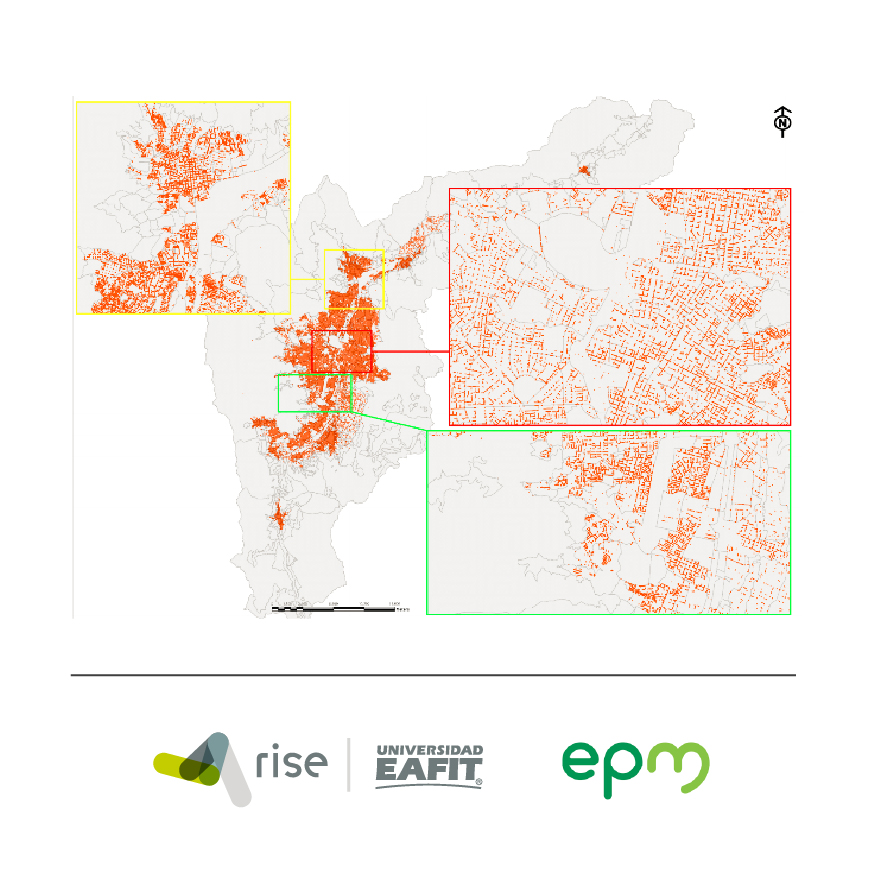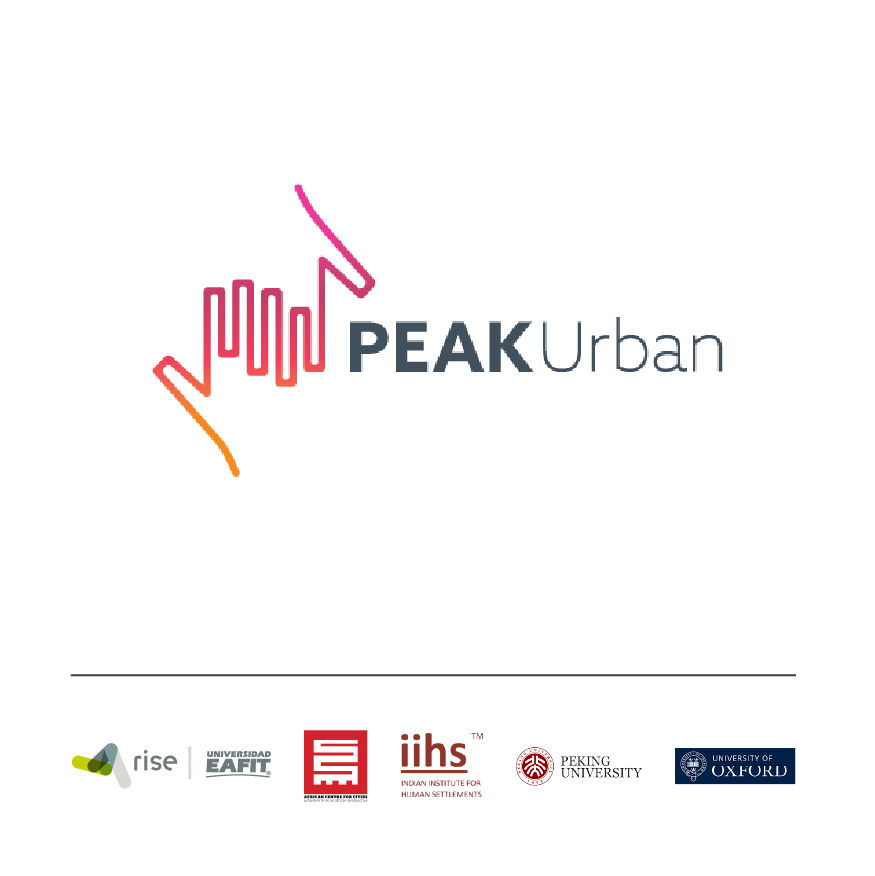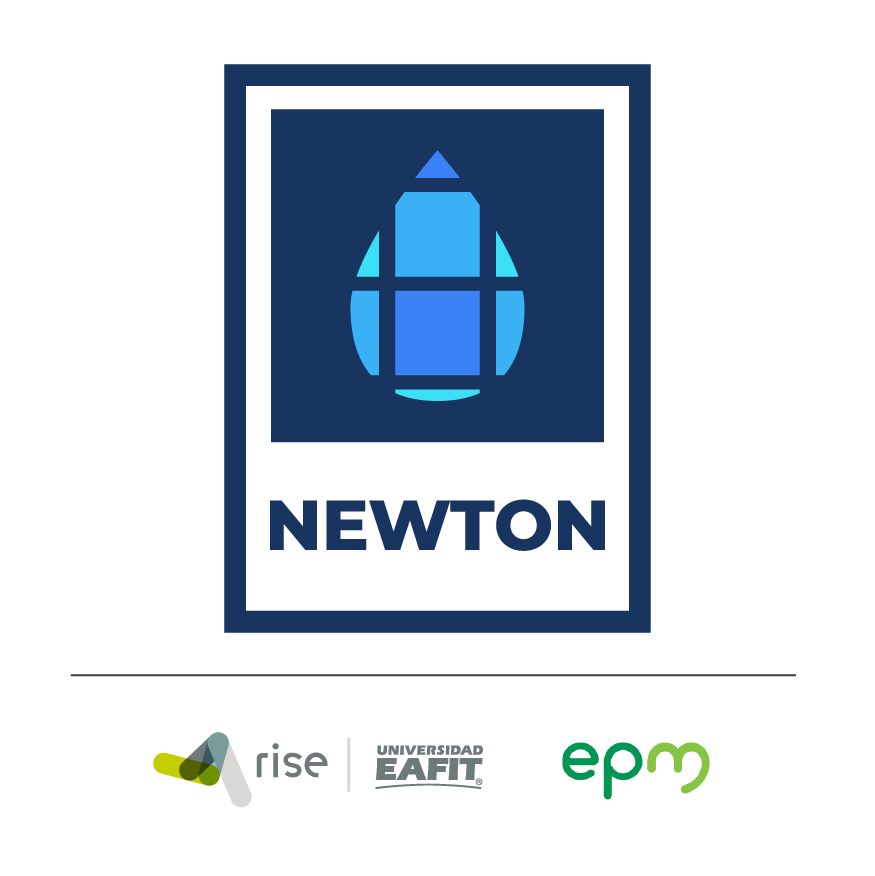Gómez, Jairo A; Guan, ChengHe ; Tripathy, Pratyush ; Duque, Juan C; Passos, Santiago ; Keith, Michael ; Liu, Jialin Analyzing the Spatiotemporal Uncertainty in Urbanization Predictions Artículo de revista Remote Sensing, 13 (3), pp. 28, 2021, ISSN: 2072-4292. Resumen | Enlaces | BibTeX | Etiquetas: Aprendizaje de máquina, Crecimiento de ciudades @article{rs13030512,
title = {Analyzing the Spatiotemporal Uncertainty in Urbanization Predictions},
author = {Gómez, Jairo A. and Guan, ChengHe and Tripathy, Pratyush and Duque, Juan C. and Passos, Santiago and Keith, Michael and Liu, Jialin},
editor = {MDPI},
url = {https://doi.org/10.3390/rs13030512},
doi = {10.3390/rs13030512},
issn = {2072-4292},
year = {2021},
date = {2021-02-01},
journal = {Remote Sensing},
volume = {13},
number = {3},
pages = {28},
abstract = {With the availability of computational resources, geographical information systems, and remote sensing data, urban growth modeling has become a viable tool for predicting urbanization of cities and towns, regions, and nations around the world. This information allows policy makers, urban planners, environmental and civil organizations to make investments, design infrastructure, extend public utility networks, plan housing solutions, and mitigate adverse environmental impacts. Despite its importance, urban growth models often discard the spatiotemporal uncertainties in their prediction estimates. In this paper, we analyzed the uncertainty in the urban land predictions by comparing the outcomes of two different growth models, one based on a widely applied cellular automata model known as the SLEUTH CA and the other one based on a previously published machine learning framework. We selected these two models because they are complementary, the first is based on human knowledge and pre-defined and understandable policies while the second is more data-driven and might be less influenced by any a priori knowledge or bias. To test our methodology, we chose the cities of Jiaxing and Lishui in China because they are representative of new town planning policies and have different characteristics in terms of land extension, geographical conditions, growth rates, and economic drivers. We focused on the spatiotemporal uncertainty, understood as the inherent doubt in the predictions of where and when will a piece of land become urban, using the concepts of certainty area in space and certainty area in time. The proposed analyses in this paper aim to contribute to better urban planning exercises, and they can be extended to other cities worldwide.},
keywords = {Aprendizaje de máquina, Crecimiento de ciudades},
pubstate = {published},
tppubtype = {article}
}
With the availability of computational resources, geographical information systems, and remote sensing data, urban growth modeling has become a viable tool for predicting urbanization of cities and towns, regions, and nations around the world. This information allows policy makers, urban planners, environmental and civil organizations to make investments, design infrastructure, extend public utility networks, plan housing solutions, and mitigate adverse environmental impacts. Despite its importance, urban growth models often discard the spatiotemporal uncertainties in their prediction estimates. In this paper, we analyzed the uncertainty in the urban land predictions by comparing the outcomes of two different growth models, one based on a widely applied cellular automata model known as the SLEUTH CA and the other one based on a previously published machine learning framework. We selected these two models because they are complementary, the first is based on human knowledge and pre-defined and understandable policies while the second is more data-driven and might be less influenced by any a priori knowledge or bias. To test our methodology, we chose the cities of Jiaxing and Lishui in China because they are representative of new town planning policies and have different characteristics in terms of land extension, geographical conditions, growth rates, and economic drivers. We focused on the spatiotemporal uncertainty, understood as the inherent doubt in the predictions of where and when will a piece of land become urban, using the concepts of certainty area in space and certainty area in time. The proposed analyses in this paper aim to contribute to better urban planning exercises, and they can be extended to other cities worldwide. |
Gómez, Jairo A; Patiño, Jorge E; Duque, Juan C; Passos, Santiago Spatiotemporal Modeling of Urban Growth Using Machine Learning Artículo de revista Remote Sensing, 12(1) (109), pp. 1-41, 2020, ISSN: 2072-4292. Resumen | Enlaces | BibTeX | Etiquetas: Aprendizaje de máquina, Crecimiento de ciudades, imágenes satelitales @article{gomez2020spatiotemporal,
title = {Spatiotemporal Modeling of Urban Growth Using Machine Learning},
author = {Gómez, Jairo A. and Patiño, Jorge E. and Duque, Juan C. and Passos, Santiago },
url = {https://doi.org/10.3390/rs12010109},
doi = {10.3390/rs12010109},
issn = {2072-4292},
year = {2020},
date = {2020-01-01},
journal = {Remote Sensing},
volume = {12(1)},
number = {109},
pages = {1-41},
abstract = {This paper presents a general framework for modeling the growth of three important variables for cities: population distribution, binary urban footprint, and urban footprint in color. The framework models the population distribution as a spatiotemporal regression problem using machine learning, and it obtains the binary urban footprint from the population distribution through a binary classifier plus a temporal correction for existing urban regions. The framework estimates the urban footprint in color from its previous value, as well as from past and current values of the binary urban footprint using a semantic inpainting algorithm. By combining this framework with free data from the Landsat archive and the Global Human Settlement Layer framework, interested users can get approximate growth predictions of any city in the world. These predictions can be improved with the inclusion in the framework of additional spatially distributed input variables over time subject to availability. Unlike widely used growth models based on cellular automata, there are two main advantages of using the proposed machine learning-based framework. Firstly, it does not require to define rules a priori because the model learns the dynamics of growth directly from the historical data. Secondly, it is very easy to train new machine learning models using different explanatory input variables to assess their impact. As a proof of concept, we tested the framework in Valledupar and Rionegro, two Latin American cities located in Colombia with different geomorphological characteristics, and found that the model predictions were in close agreement with the ground-truth based on performance metrics, such as the root-mean-square error, zero-mean normalized cross-correlation, Pearson’s correlation coefficient for continuous variables, and a few others for discrete variables such as the intersection over union, accuracy, and the f1 metric. In summary, our framework for modeling urban growth is flexible, allows sensitivity analyses, and can help policymakers worldwide to assess different what-if scenarios during the planning cycle of sustainable and resilient cities.},
keywords = {Aprendizaje de máquina, Crecimiento de ciudades, imágenes satelitales},
pubstate = {published},
tppubtype = {article}
}
This paper presents a general framework for modeling the growth of three important variables for cities: population distribution, binary urban footprint, and urban footprint in color. The framework models the population distribution as a spatiotemporal regression problem using machine learning, and it obtains the binary urban footprint from the population distribution through a binary classifier plus a temporal correction for existing urban regions. The framework estimates the urban footprint in color from its previous value, as well as from past and current values of the binary urban footprint using a semantic inpainting algorithm. By combining this framework with free data from the Landsat archive and the Global Human Settlement Layer framework, interested users can get approximate growth predictions of any city in the world. These predictions can be improved with the inclusion in the framework of additional spatially distributed input variables over time subject to availability. Unlike widely used growth models based on cellular automata, there are two main advantages of using the proposed machine learning-based framework. Firstly, it does not require to define rules a priori because the model learns the dynamics of growth directly from the historical data. Secondly, it is very easy to train new machine learning models using different explanatory input variables to assess their impact. As a proof of concept, we tested the framework in Valledupar and Rionegro, two Latin American cities located in Colombia with different geomorphological characteristics, and found that the model predictions were in close agreement with the ground-truth based on performance metrics, such as the root-mean-square error, zero-mean normalized cross-correlation, Pearson’s correlation coefficient for continuous variables, and a few others for discrete variables such as the intersection over union, accuracy, and the f1 metric. In summary, our framework for modeling urban growth is flexible, allows sensitivity analyses, and can help policymakers worldwide to assess different what-if scenarios during the planning cycle of sustainable and resilient cities. |
Duque, Juan C; Lozano-Gracia, Nancy ; Patino, Jorge E; Restrepo, Paula ; Velasquez, Wilson A Spatiotemporal dynamics of urban growth in Latin American cities: An analysis using nighttime light imagery Artículo de revista Landscape and Urban Planning, 191 (103640), pp. 1-15, 2019, ISSN: 0169-2046. Resumen | Enlaces | BibTeX | Etiquetas: Crecimiento de ciudades, imágenes satelitales @article{duque2019spatiotemporal,
title = {Spatiotemporal dynamics of urban growth in Latin American cities: An analysis using nighttime light imagery},
author = {Duque, Juan C. and Lozano-Gracia, Nancy and Patino, Jorge E. and Restrepo, Paula and Velasquez, Wilson A.},
url = {https://doi.org/10.1016/j.landurbplan.2019.103640},
doi = {10.1016/j.landurbplan.2019.103640},
issn = {0169-2046},
year = {2019},
date = {2019-11-01},
journal = {Landscape and Urban Planning},
volume = {191},
number = {103640},
pages = {1-15},
abstract = {The impact of urban form on economic performance and quality of life has been widely recognized. Studies regarding urban form have focused on developed countries; only a small number of cities in developing countries have been studied. This paper utilizes nighttime light imagery and information regarding street networks, automatically retrieved from OpenStreetMap, to calculate a series of spatial metrics that capture different aspects of the urban form of 919 Latin American and Caribbean cities. We study the relationship between the urban form metrics and several factors that can correlate with urban form (topography, size, colony, and economic performance) and perform a spatiotemporal analysis of urban growth from 1996 to 2010. Among the results, we highlight the tendency of a group of cities to grow on steeper slopes and several worrying aspects, specifically urban growth in protected areas and a trend to sprawl-growing in certain Latin American and Caribbean cities.},
keywords = {Crecimiento de ciudades, imágenes satelitales},
pubstate = {published},
tppubtype = {article}
}
The impact of urban form on economic performance and quality of life has been widely recognized. Studies regarding urban form have focused on developed countries; only a small number of cities in developing countries have been studied. This paper utilizes nighttime light imagery and information regarding street networks, automatically retrieved from OpenStreetMap, to calculate a series of spatial metrics that capture different aspects of the urban form of 919 Latin American and Caribbean cities. We study the relationship between the urban form metrics and several factors that can correlate with urban form (topography, size, colony, and economic performance) and perform a spatiotemporal analysis of urban growth from 1996 to 2010. Among the results, we highlight the tendency of a group of cities to grow on steeper slopes and several worrying aspects, specifically urban growth in protected areas and a trend to sprawl-growing in certain Latin American and Caribbean cities. |
Gómez, Jairo A; Patiño, Jorge E; Duque, Juan C; Passos, Santiago Hacia un futuro más sostenible a través del modelado, planificación y control del crecimiento urbano basado en datos Informe técnico RiSE-group (1), 2020. Resumen | Enlaces | BibTeX | Etiquetas: briefings, Crecimiento de ciudades, imágenes satelitales @techreport{peak_briefing_1s,
title = {Hacia un futuro más sostenible a través del modelado, planificación y control del crecimiento urbano basado en datos},
author = {Gómez, Jairo A. and Patiño, Jorge E. and Duque, Juan C. and Passos, Santiago},
url = {https://www.rise-group.org/wp-content/uploads/2021/01/briefing_1.pdf
https://www.rise-group.org/wp-content/uploads/2021/03/briefing_1e.pdf},
year = {2020},
date = {2020-08-01},
number = {1},
institution = {RiSE-group},
abstract = {Este informe de investigación destaca el valor de utilizar un modelo de crecimiento urbano basado en datos para predecir el impacto de ciertas decisiones administrativas y políticas en la expansión o densificación a largo plazo de una ciudad. Cuando el modelo se usa como parte del ciclo de planificación urbana (ver Figura 1), sirve como un mecanismo para la toma de decisiones que apoya el crecimiento sostenible. Para otros actores urbanos interesados,como empresas de servicios públicos y constructoras, el modelo puede proporcionar información valiosa de planificación para la demanda futura de servicios e infraestructura.},
keywords = {briefings, Crecimiento de ciudades, imágenes satelitales},
pubstate = {published},
tppubtype = {techreport}
}
Este informe de investigación destaca el valor de utilizar un modelo de crecimiento urbano basado en datos para predecir el impacto de ciertas decisiones administrativas y políticas en la expansión o densificación a largo plazo de una ciudad. Cuando el modelo se usa como parte del ciclo de planificación urbana (ver Figura 1), sirve como un mecanismo para la toma de decisiones que apoya el crecimiento sostenible. Para otros actores urbanos interesados,como empresas de servicios públicos y constructoras, el modelo puede proporcionar información valiosa de planificación para la demanda futura de servicios e infraestructura. |




